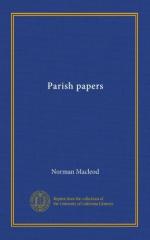A Christian congregation professes to be a congregation of Christians, and to represent the same kind of body which, in the apostolic epistles, is termed a “church”—“saints and faithful brethren”— “faithful in Christ Jesus”—“holy brethren.”
It is not, therefore, a number of people meeting only to hear a sermon, or even to unite in public worship, but without any visible coherence, social life, or united action, but a body, an organised whole; the Lord’s Supper being the grand symbol of the unity of its members with one another, and with the whole society of the Christian Church on earth and in heaven.[A]
[Footnote A: The social character of the Lord’s Supper, and its being a constant witness to the oneness of the whole body of Christ and the communion of saints, has been often so perverted as to have become in the minds of many the grand test and evidence of sectarian division, while “hearing a sermon” is the utmost latitude which is given to the believer who wishes to testify his love to all who love the Lord Jesus in sincerity. “I would hear him preach, but I would not join with him,” (i.e., I would not remember Christ with him,) is the strange view of many a professing Christian, in Scotland at least.]
Now, the congregation, as an organised Christian society, has a twofold work to perform. The first is within itself, and includes whatever is done by the members of the congregation for their mutual good; the second is beyond itself, and includes the good done by the whole body to the world “without.”
It is thus with the living body of the Church as with the dead machinery of a steam-engine, which first feeds itself with coals and water, and then turns the wheels of the whole factory.
The inner and outer work of the congregation as a body may be briefly indicated in a few sentences, though volumes might be profitably filled with its details.
1. The inner work is accomplished within the soul of each member through the preaching and reading of the Word of God, public prayer, and partaking of the sacrament. By these means chiefly comes that “kingdom of God which is within us,” and is “righteousness, peace, and joy in the Holy Ghost,” Every other work will be done efficiently by the whole body just as this inner work begins and progresses among its individual members. But the fellowship and mutual aid of the members of the Church in “considering one another, and provoking to love and good works,” and in contributing their share of God’s gifts and grace bestowed upon themselves for the comfort and edification of their brethren, also belongs to the inner work of the Church. This will express itself and be strengthened by meetings for social prayer and Christian intercourse, and by those works and labours of love for which the congregation itself has the first claim. These labours of love include the religious instruction of its young members the baptized children; the visitation of sick; its support of the poor and destitute brethren. In these and other forms of well-being and well-doing which will suggest themselves, abundant scope will, in most cases, be afforded for exercising the energies, and calling forth the love of the members of the congregation within the limits of their own society.




